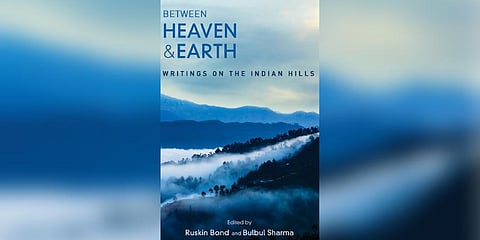

Like siblings who grow up together and grow apart later, Between Heaven and Earth: Writings on the Indian Hills, edited by Ruskin Bond and Bulbul Sharma, offers essays that are similar in subject, but varied in tone. They are, in more ways than one, an ode to a time, a life, and nature of a bygone era. Some of the pieces were written more than a century ago and the problems the authors speak of revolve around man-eating wild animals and rapid urbanisation. Themes of casteism and classism inadvertently flow through the text.
Hill stations, the essays show, were essentially designed to replicate a home away from home for the British, living in India in the 19th century. That’s how these spots turned into summer palaces. The mansions, inviting weather, and the proximity to nature made these places popular hangouts where the sojourners could let their guards down. Of course, there was always the threat of a tiger making a surprise cameo, but that was likely a minor hassle to enjoy the joys these secluded homes had to offer.
Several wishful thinkers, raised in metropolitan areas, fantasise about opening cafes, bookstores and living the quiet life where the clouds meet their palms, but life in the hills isn’t all that easy. Only a handful would be able to survive the winds and chills. Besides, the forests are said to never sleep. Natives marry the roots of darkness to spookiness. Not surprisingly, large sections of the collection are dedicated to the ghosts and gods of the hills.
Nicholas Roerich and Murugeshwari in their essays, ‘The Gods of Kuluta’ and ‘Dancing with the Goddess’ respectively, describe, in detail, the rituals that are associated with local celebrations. Bijoya Sawian in ‘Memories of My Shillong’, writes, “There is a hill, soaring heavenwards, and on that hill-top he lives, Lei Shyllong, the Protector of our land. Shillong, my home, where my spirit roams even when I am away, takes its name from this deity.” The writers turn to picturesque villages as though they are their guardians. That’s why, perhaps, the preface opens with Rudyard Kipling’s quote, “Who goes to the hills, goes to his mother.”
It is challenging to quantify the charm of hills, but they have universally served as an escape for writers, who find it liberating to be with their thoughts amid the rustling of the leaves. For company, they always have the rare birds and animals that pay them a visit every now and then.
Among the essays that are sure to strike a chord is Mihir Vatsa’s very intimate piece about growing up in the hills of Hazaribagh in Jharkhand. He writes, “One of my favourite things to do when I lived in Delhi as a student and later as an advertising professional was to look up Hazaribagh on Google. Many of my old friends were happy to have made the transition from a small town to their respective cities where they studied. I, on the other hand, would miss the forest, the landscape and the climate of Hazaribagh. I just wouldn’t stop talking about it!”
The only thing that doesn’t work for the collection is how the hills in the south of India have completely been overlooked. There are numerous hills below the Vindhyas that evoke the same measure of awe and inspiration, and excluding them is an enormous loss for the reader.
If the stories aren’t enamouring enough, the book also features a number of photographs to bring the hills to life, tempting one to make a note of all the cool places to check off the travel bucket list.Since most of the authors that make up this collection are well-known to bibliophiles––Rabindranath Tagore, Jim Corbett, Jawaharlal Nehru, Khushwant Singh––it is bound to find a spot on many bookshelves. It’s a hit formula.